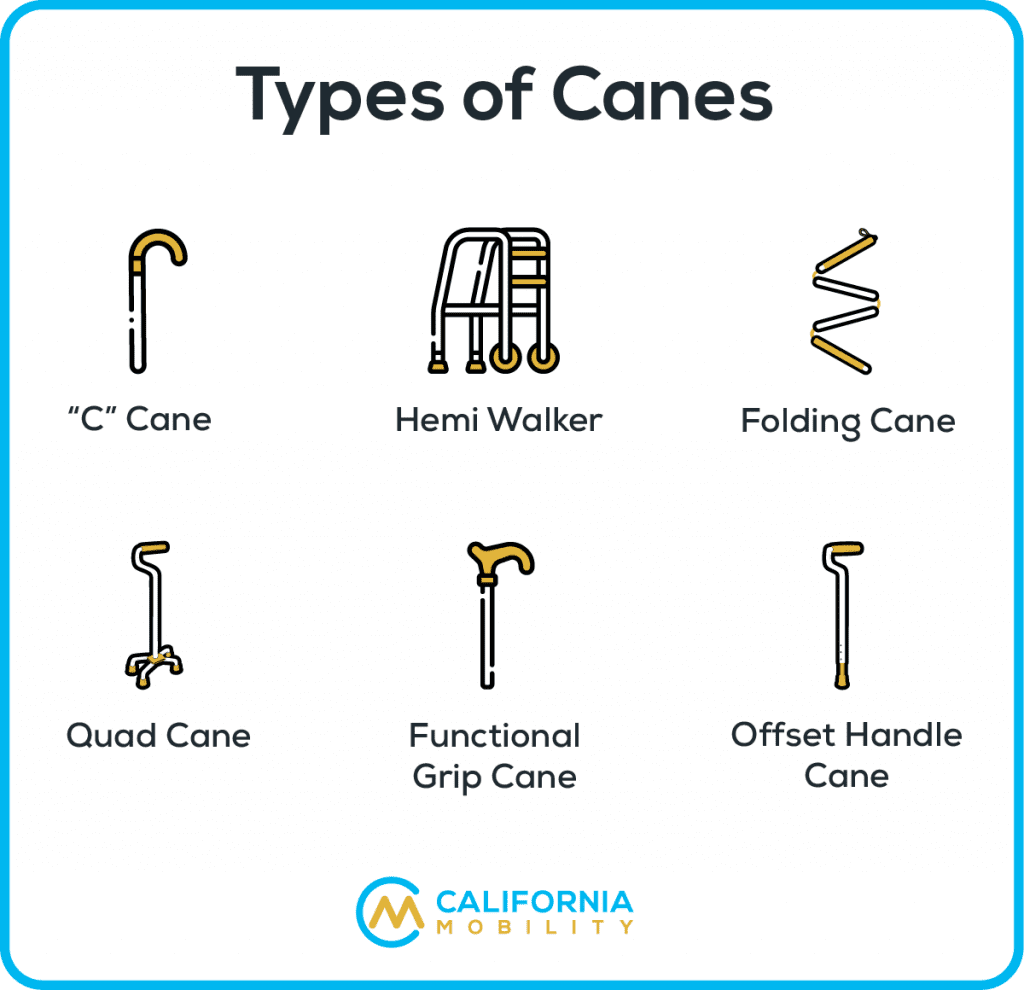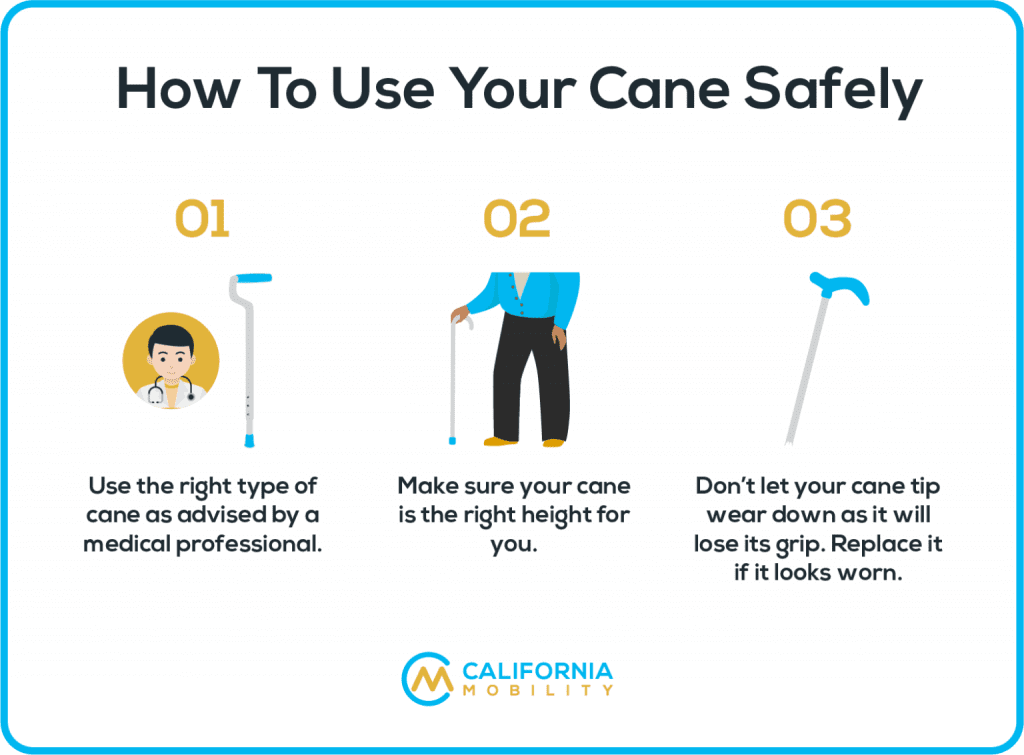Ultimate Guide to Choosing and Using a Walking Cane

Table of Contents
One in four US adults, aged 65 or over, suffers a fall each year. According to the Centers for Disease Control and Prevention, falls are the leading cause of fatal injuries in older Americans.
Learning how to use a walking cane can help prevent falls and resulting injuries by improving balance and stability while walking. It can also help those who have suffered an injury or have a disability that makes walking difficult.
Although canes can be helpful, choosing the right one is not as straightforward a task as it might sound. From finding the right type of cane to ensuring you have the proper cane height, there are multiple factors to consider. You should consult a physician or physical therapist while deciding which cane is right for you, but it’s helpful to know what’s available. In this article, we will guide you through how to choose a cane and how to use it correctly. Let’s get started!
The Most Common Reasons for Needing a Cane
There are a plethora of reasons someone might benefit from the use of a cane, but here are some of the most common:
- Hip replacement surgery
- Other types of surgery affecting the back or lower limbs
- Pain in joints caused by arthritis
- Back pain, especially lower back pain and that associated with obesity
- Ankle, knee, or another leg injury
How to Choose a Cane
Choosing the right cane is imperative to ensure that it does its job correctly. Using the wrong type of walking cane can lead to bad posture or unsafe walking, resulting in increased risk of injury. Indeed, Dr. Rein Tideiksaar points out, “Canes and walkers help elders to maintain their balance and mobility, yet at the same time they can also be a fall hazard.”
We’ll go into some of these in more detail below, but here are the basic steps to take to ensure you make the right choice:
- Consult a physician to understand which type of cane is best for your needs.
- Decide on the type of cane and the type of grip that will suit you.
- Choose a cane that is durable and has a lot of good reviews from others.
- Size your cane so that it’s comfortable and doesn’t risk causing additional injury.
Types of Canes

With so many canes on the market, it can be confusing to decipher what each one is for. Below we list and describe some common types of canes. Bear in mind that some of these may be combined. For example, many quad canes have a functional grip and are foldable.
Some common types of cane are:
| Type of Cane | Features | Pros | Cons |
|---|---|---|---|
| “C” Cane | Single-tip straight cane with a curved (C-shaped) handle. | • Provides some support • Widely available | • Not suitable for people requiring more than light support • Don’t stand alone |
| Functional Grip Cane | Straight single-tip cane with a straight handle (perpendicular to the main shaft). | • Easy to grip • Provides more support than a “C” cane • Widely available • Often foldable for easy storage • Often have adjustable height | • Most don’t stand alone • Not as supportive as a quad cane |
| Offset Handle Cane | The design ensures the user’s weight is centered such that it bears mainly on the strongest part of the cane. | • Improved weight distribution • Provides more support than a standard functional grip cane | • Still not as supportive as a quad cane • Most don’t stand alone |
| Quad Cane | Rather than a single tip, this has four supports at the bottom, forming a rectangular base of varying size. | • Four supports provide more stability • Stands independently • Often has adjustable height | • Can be more cumbersome and difficult to maneuver than a single-tip cane • Typically can’t fold for storage |
| Hemi Walker | Has an even larger base than a quad cane and is often used by those transitioning to or from a walker. | • Provides the most support | • More cumbersome • Difficult to use on stairs |
| Folding Cane | A folding cane is a regular cane that can be folded. | • Lightweight • Ideal for on-the-go • Typically have adjustable height | • May not be as sturdy as other canes |
Sizing Your Cane
One of the most important steps to take before using a cane is to ensure it’s the right size. If a cane is too long, it will be more difficult to pick it up to move it while you walk. A too short cane could cause the user to lean to the side, and can actually worsen balance.
Buying an adjustable cane makes sizing a lot easier. For this type, follow these steps to make sure you have the proper cane height:
- Always consult your physical therapist or doctor to make sure that your cane is right for your specific condition.
- Hold the walking cane in the opposite hand to the affected or weakest leg.
- The cane should be at the same level as the hip bone on the upper thigh.
- The elbow should be bent at roughly a 20-degree angle when the hand is resting on the cane.
While many canes are easily adjustable, you might opt for one that isn’t. In this case, it might need to be cut to size. If you need to supply measurements for a custom cane or are cutting it for yourself, follow these steps that explain how to measure for a cane:
1. Wear your regular walking shoes to take the measurements.
2. Stand in an upright position and let your arms fall naturally to your sides (elbows bent roughly at a 20-degree angle).
3. While in this position, have someone measure the distance between the floor and your wrist joint.
4. This is the correct measurement for the length of your cane (from the tip to the lowest point of the top of the handle).
Important Cane Features
On your hunt for the perfect cane, there are going to be lots of things to bear in mind. Aside from finding the right type and size of walking cane, here are some other criteria to consider:
- Adjustable height: Purchasing an adjustable cane means you can ensure you always have the right fit. Plus you don’t have to deal with cutting a cane to the right size.
- Good grip handle: This is often a matter of preference, but the right grip can reduce joint stress and prevent joint deformities. Grips come in different shapes and materials, and your physician or physical therapist can help you decide which one to go for.
- Quality material: You need to know that your cane is going to be reliable and last a long time. Choosing a durable material will reduce the risk of being without a cane and will mean having to replace it less often.
Additional features: Depending on your individual situation, you might need a cane that has some unique features. For example, some canes provide an additional handle to help with getting up from a sitting position. Others actually include a seat in their design in case you need to take regular breaks.
Top-Rated Canes
We covered some of the most common types of canes above, but here we’ll look at a top-rated example of each.
- Drive Medical “C” Cane
- Made with extruded aluminum tubing
- Has adjustable height with locking ring
- Features a comfortable foam grip
- RMS Functional Grip Cane
- Made to fit the user’s hand perfectly
- Has a lightweight aluminum shaft
- Uses a replaceable, slip-resistant rubber tip
- Medline Offset Handle Cane
- Has an offset handle for improved weight distribution
- Features a push-button for adjusting height
- Includes a locking ring for safety and to prevent rattling
- VIVE Quad Cane
- Provides a nonslip four-pronged base for stability
- Has an ergonomically contoured grip and wrist strap
- Utilizes a corrosion-resistant anodized aluminum frame
- Drive Medical Hemi Walker
- Offers more stability than a cane but is more lightweight than a walker
- Provides a wide base of support
- Can be folded easily with just one hand
- Kitchen Krush Folding Walking Cane
- Folds into four sections and is secured with a belt
- Features an anti-marking rubber tip
- Has a comfortable plastic handle
How to Use Your Cane

Once you’ve landed on the perfect cane, it’s time to get moving. But before you do, bear in mind the following tips regarding how to use a cane properly:
- How to use a cane safely:
- Use the right type of cane as advised by a medical professional.
- Make sure your cane is the right height for you.
- Don’t let your cane tip wear down as it will lose its grip. Replace it if it looks worn.
- How to use a cane on a level surface:
- Hold the cane in your hand on your unaffected side so that it provides support to the opposite lower limb.
- Advance the cane simultaneously with the affected leg.
- Keep the cane in place when you step forward with the unaffected leg.
- Lean your weight through the arm holding the cane as needed.
- Always have the unaffected lower limb assume the first full weight-bearing step on level surfaces.
- How to use a cane on stairs:
- Hold onto the railing with your free hand if possible.
- To go upstairs, if you have a leg injury or disability, step up with the stronger leg first. Then move the cane as you step up with the affected leg.
- To go downstairs, move your cane to the lower step first, followed by your affected leg. Finally, move your unaffected leg.








